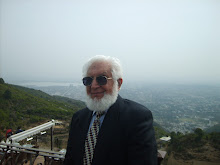From the blog of I.A. Bhopal Saheb and comments on this subject I got somewhat mixed up So I reconsulted the fiqh books. Following is the way I understand and if my impressions are incorrect , the reader is requested to point out. (and oblige me)
"Qiyam-ul-Lail" is a general (?generic) word for supernumery night prayers.
"Tahajjud" is a specific night prayer offered AFTER Isha (Obligatory) prayer and can also be offered after sleeping some, actually prefered at late night before Fajr.
"Taraweeh" is another type of 'Qiyam' specifically offered in Ramadhan. There is no doubt Minimum offered by the prophet PBUH were 8+3. both at home and in the Masjid. He, through his behavior demonstrated restraint and 'suggested' to sahaba to offer at home (also) instead of masjid. ( I am not describing hadithes for keeping it short)
He did finish reciting Quran during his last Ramadhan (in ?taraweeh) twice (Jibreel AS listening)
Umar RA instituted (out of necessity, to create some order) during his Khilafat, the way we are doing it now. The number of raka't from 8 to 20 (plus Witr which itself can be one or three raka't). ( Maliki takes up to 36 Raka's of taraweeh)
Generally Witr is considered the last prayer of the night (Hanafi) BEFORE sleeping but can be offered late night AFTER sleeping. By this I understand that 'taraweeh' is NOT offered AFTER Witr. Tahajjud is offered (in other months) even after Witr. (Thus distinguishing taraweeh from tahajjud, though they are 'alike' in being "qiyam-ul-lail)
(OR, is there is no harm in altering the 'sequence' of all these night prayers, as long as they are sandwitched between Isha and Fajr?)
To me these differences and the prophet's attitude gives a lot of options and anybody can do whatever he can do or likes to do within these limits. AND one can skip the masjid any time (for the taraweeh only Isha) and as many times as he wishes to but offering the taraweeh at home instead. Maybe Allah wanted us to ENJOY these options so He made His rasool SAWS do that.
At present In the Haramain Shareefain Ramadhan Qiyamul-lail during the last Ashrah is offered as under:
20 Taraweeh after Isha (Regular Quran recitation for finishing Qur'an usually on Jumu'at-ul-wid'a), followed by witr.
Four Rak'a further Qiyam (with longer Rukoo' and Sujood) +one Witr, later in the night finishing about an hour before Fajr (for Sahoor or Sahri). Qur'an recitation longer surahs but not for second finish of Qur'an.
We have multiple mazdahib Muslims in our Islamic center and we have done the same as above with the following difference
8 taraweeh after Isha
2+1 (Non-Hanafi) or 3 together (Hanafi recommendation) Witr (Non-hanafi method), the Qunoot being mostly after Rukoo' and much longer dua.
(I am calling it Hanafi and Nonhanafi for lack of better expression. Hanafi recommendation for Qunoot being BEFORE rukoo'a and Offered 'quietly' and Non-Hanafi recommendation being AFTER rukoo'a and Imam utters dua Qunoot with voice)
After that the Huffazd take up the 12 more raka'ats with continuation of Quran (Apportioned for that night). This is followed by Witr for those who have not done before--- And Yes another Imam comes for the rest of the Qiyam of 4 + one Raka'ts, with longer rukoo' and sujood ( and Qur'an recitation other than the apportioned schedule). Those who did not do witr before do it now. (Understand that Witr is NOT repeated for obvious reasons, by individuals.)
Despite all these, I find this 'Optionality' most pleasing. The prophet had his own reasons for reducing hardship on Ummah. Ummah however not only indulges in more 'hardship' but even ENJOYS it (more than the "prescribed" or Fard prayers). This phenomena is amazing and year after year I watch the Masjid filling up and overflowing from just before Ramadhan and back to 'usual' thinning of crowds just after Ramadhan. As Umar (RA) says it is "Bid'ah Hasanah". (I, like many of you now even look forward to Ramadhan season)
Those of you who have had the experience of spending last Asharah in Haramain Shareefain know what I am talking about. It is just awsome. Hamaray nabi per lakhon aur karorron darood aur Allah SWT Nabi SAWS per apni salamtain aur rahmatain nazil karay-AAmeen


